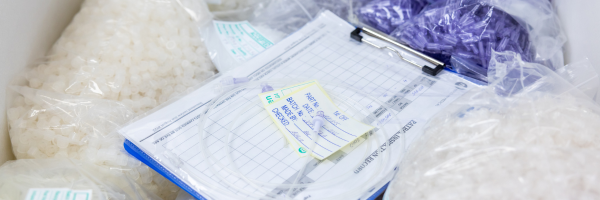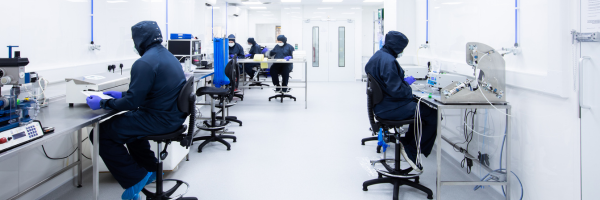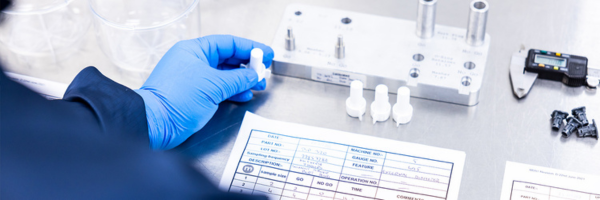A practical, quick reference-style audit checklist
A free Audit checklist to help you audit your suppliers
As a medical devices assembly expert, and having worked with many medical device companies, quality assurance professionals and notified bodies, we understand the intricacies of selecting a suitable supplier for your project.
We have designed a short but comprehensive Medical Device Supplier Audit Checklist with your needs in mind. It is designed for people new to performing audits as a user-friendly checklist to guide you through the auditing process, empowering you to:
✓ take a systematic approach
✓ ensure comprehensive coverage of all relevant areas
✓ guarantee consistency
✓ comply with pertinent regulatory requirements
✓ mitigate potential risks associated with suppliers’ processes and products
✓ verify that suppliers maintain proper documentation
✓ use your time and resources efficiently and, most importantly,
✓ develop a solid foundation for objective evaluation, comparing suppliers against predefined criteria
We hope you find this guide, complete with our comprehensive checklist useful.

James Fenton
Managing Director, Meridian Medical
Looking for a medical device assembly expert? Find out more about Meridian Medical’s services here
What is an audit?
A supplier audit is a methodical and independent examination that is conducted to determine the effectiveness of the companies Quality Management System (QMS). The Audit should encompass the supplier’s structure, responsibilities, procedures, processes and resources for implementing quality management during the production of your medical device.
It is essential for auditors to maintain their independence, ensuring impartiality and freedom from influences that could compromise their objectivity.

What does the auditing process include?
A typical supplier audit will include the following steps, as set out by the Global Harmonization Task Force, a group of representatives from national medical device regulatory authorities and the regulated industry: In brief you should be reviewing the company quality manual and ensuring that the manual meets the required standards and that you can be provided with evidence that the company is following its own procedures.
1. Notification
The company to be audited should be notified in advance that an audit is to be conducted if the associated regulatory requirements allow. It’s good practise to allow at least a month, however the sometimes audits do need to happen last minute for a number of reasons. If your audit is required urgently, give the supplier a call and see if they can accommodate you.
2. Quality Management System preview
In order to plan the audit, the lead auditor can perform a preparatory review of the supplier’s documentation, usually their Quality Management System manual. This review assesses whether the supplier’s documentation meets regulatory requirements and is an early indicator of whether concerns regarding the documentation must be resolved before the planned audit can be carried out.
3. Site visit plan
The site visit should be agreed to by the supplier in advance, where the regulatory requirements permit.
An audit plan should ideally include:
- the scope and purpose of the audit
- identification of the supplier’s management team
- identification of reference documents (such as the Quality Management System manual)
- identification of your audit team members
- the date and location of where the site visit is to be performed
- the date and location of where any additional documentation is planned for review if necessary
- identification of the supplier’s organisational units
- the estimated time and duration for each audit activity
- the meeting timetable, incorporating any essential daily briefings, to be arranged with the management team of the supplier
- the estimated audit report distribution date
4. Preparation of essential documents
Your lead auditor is responsible for creating the necessary documents to conduct the audit, designed to support the collection of objective evidence and impartial reporting of results. This can include:
- a checklist to assess the Quality Management System compliance with regulatory requirements. This will help keep the audit on track.
- a report template to record any observations as found. This should have the document number, revision, or the location of the process or product, so that it can be clearly referenced later.
- an audit conclusion template to record evidence to support non-conformities arrived at by the auditor.
5. Kick-off meeting
Holding an introductory meeting helps to prepare all parties involved for the audit. Typically, the kick off meeting will include:
- an introduction of the audit team to the supplier’s Quality assurance team
- a review and agreement of the scope and objectives of the audit
- a review of the methods and procedures to be used to perform the audit
- an outline of the official communication channels between the auditor and the supplier
- agreement on the resources required by the auditor to conduct the audit
- confirmation of the date and location for the closing meeting
- explanation of any unclear details of the audit plan itself
- In our experience lunch is provided for the audit team, and any dietary requirements should be disclosed.
6. On-site examination
The on-site examination will allow the auditor to:
- assess whether the supplier’s documented Quality Management System complies with the regulatory requirements outlined in the audit plan (further to the aforementioned documentation preview)
- verify the execution of the supplier’s procedures.
- ensure that the manufacturer’s Quality System is effective.
Collecting objective evidence:
Objective evidence should be gathered through interviews, document scrutiny, and visual observation. Interviews should be cross-validated with independent sources such as observation and records. Quality audit findings should be recorded based on this evidence, with documentation and acknowledgment. Try to stay on track with your quality plan and ensure you don’t get side tracked with processes or documents not related to the purpose of your audit.
Quality audit observations gathering:
Document quality audit observations and non-conformities accurately. Promptly discuss identified nonconformities with the supplier. Document nonconformities clearly, with objective evidence, and specify any unmet requirements. Give the supplier every opportunity to close out the non-conformity during the audit. It saves paperwork for all parties later down the line.
7. Wrap-up meeting
In the wrap-up meeting, the lead auditor can share the audit observations to the supplier’s management team, outlining which ones are observations and which nonconformities. Conclusions about the effectiveness of the Quality System in meeting regulatory requirements and quality objectives set out in the predetermined audit plan must also be included.
The supplier should acknowledge the list of identified nonconformities, and both the auditor and supplier should agree to a date of submission for corrective action plans designed to address them.
Download our ready-to-use audit checklist here

What should a medical device supplier audit cover?
An audit of a medical device supplier should cover various aspects to ensure compliance with regulations, adherence to quality standards, and overall reliability. Here are the distinct areas that should be included in a comprehensive audit:
Quality Management System (QMS):
- Evaluate the effectiveness of the supplier’s QMS in ensuring the quality and safety of medical devices
- Assess documentation, procedures, and records related to quality management
Regulatory Compliance:
- Confirm compliance with relevant regulatory requirements, including local and international standards (e.g., ISO 13485, FDA regulations)
- Review documentation for regulatory approvals and certifications
Product Design and Development:
- Assess the processes for designing and developing medical devices, ensuring they meet specifications and regulatory requirements
- Review design controls, risk management, and validation processes
Supplier Controls:
- Evaluate procedures for selecting, qualifying, and monitoring suppliers of components or services critical to medical devices assembly
- Verify that the supplier has established controls over its own suppliers
Production Processes:
- Examine the manufacturing processes to ensure they are well-defined, controlled, and capable of producing consistent and high-quality products
Quality Control and Testing:
- Review processes for quality control and testing at various stages of production
- Confirm that the testing methods are validated and meet regulatory requirements
Traceability and Documentation:
- Ensure proper documentation and traceability of materials, components, and finished products
- Verify the accuracy and completeness of batch records and device history records
Complaint Handling and Corrective Actions:
- Assess the supplier’s procedures for handling customer complaints
- Review corrective and preventive action (CAPA) processes to address identified issues
Risk Management:
- Evaluate the supplier’s approach to identifying, assessing, and mitigating risks associated with their products and processes
Facility and Equipment:
- Inspect manufacturing facilities, ensuring they are suitable for the production of medical devices
- Assess the calibration and maintenance of equipment
Recordkeeping and Documentation:
- Confirm that the supplier maintains accurate and complete records related to quality, production, and regulatory compliance

Download our handy audit checklist here
What are the key features of a successful audit?
Indicators of a successful audit include:
Clear Objectives:
The audit should have well-defined objectives and scope, outlining what the audit aims to achieve and what the specific areas to be assessed are.
Thorough Planning:
Detailed planning is essential, including the identification of audit criteria, selection of audit team members, scheduling, and resource allocation.
Competent Audit Team:
A successful audit involves a competent and skilled audit team with expertise in relevant areas. Team members should have a good understanding of the audit process and the industry being audited.
Effective Communication:
Clear and effective communication is crucial throughout the entire audit process. This includes communication between the audit team and the supplier’s management team.
Independence and Objectivity:
The audit team should operate independently and objectively, free from any undue influence or bias, to ensure an impartial assessment of the audited entity.
Compliance with Standards:
The audit should adhere to established standards and guidelines, whether they are regulatory requirements, industry standards, or internal policies and procedures.
Risk-Based Approach:
A successful audit often employs a risk-based approach, focusing on areas of higher risk to your organisation, or where non-compliance could have significant consequences for your end product.
Documented Evidence:
The audit should be based only on documented evidence, with the audit team collecting and analysing relevant information to support their findings and conclusions.
Open communication with the supplier:
Fostering an open and collaborative relationship with the supplier being audited, and encouraging them to provide information and address concerns that arise.
Timely Reporting:
A successful audit includes timely reporting of findings and recommendations. This allows the supplier to take corrective actions promptly.
Constructive Feedback:
The audit process should provide constructive feedback to the supplier, focusing not only on areas of non-compliance but also on opportunities for improvement.
What are the critical signs of an unsuccessful audit?
The presence of one or more significant nonconformities suggests that the manufacturer is not in adherence to applicable regulatory requirements and quality control standards. Instances of quality audit observations that could be categorised as these nonconformities include the following:
- the supplier is not supportive or helpful during the audit.
- the audit goes over the allotted time due to too many non-conformities.
- non-compliance with regulatory requirements that could pose risks to product safety and effectiveness;
- ineffective Quality Management Systems that fail to ensure the consistent production of high-quality medical devices;
- insufficient documentation, including missing records, incomplete batch records, or poorly maintained documentation related to quality or regulatory compliance;
- the supplier consistently cannot find required documents.
- failure to implement robust risk management practices, potentially leading to inadequate identification, assessment, and mitigation of risks associated with the medical devices;
- identifying weaknesses in manufacturing processes that compromise the quality, consistency, or safety of medical devices;
- identifying shortcomings in testing procedures and quality control measures, leading to an increased likelihood of defective or non-compliant products;
- identifying a lack of or inadequacies in the corrective and preventive action processes, indicating a failure to address and prevent recurring issues;
- identifying deficiencies in the handling of customer complaints, suggesting a lack of responsiveness to customer concerns and potential product issues; unwillingness or inability to acknowledge and address identified issues.

Selecting your supplier
How should the results of your audit be used to select a medical device supplier?
Selecting a medical device supplier is a critical decision that directly impacts product quality, regulatory compliance, and overall business success. The results of an audit play a crucial role in informing this selection process. Here’s how you can use the audit results to make an informed decision when choosing a medical device supplier:
Risk Assessment:
Evaluate the identified risks and non-conformities from the audit. Assess the severity and potential impact of these issues on the quality of your end product and regulatory compliance.
Regulatory Compliance:
Review the audit findings related to regulatory adherence and ensure that the supplier has the necessary certifications and approvals.
Quality Management Systems:
Examine the effectiveness of the supplier’s QMS in terms of producing a consistently acceptable level of quality. Consider how the supplier addresses and mitigates risks within its quality management processes.
Corrective Actions:
Assess how the supplier handles corrective and preventive actions (CAPA) based on your audit findings. A robust CAPA system demonstrates the supplier’s commitment to continuous improvement and addressing identified issues promptly.
Documentation and Recordkeeping:
Review the completeness and accuracy of the supplier’s documentation and recordkeeping. A reliable supplier maintains thorough records, ensuring traceability and transparency in their processes.
Communication and Transparency:
Assessing the supplier’s willingness to share information, address concerns, and collaborate is essential for a successful partnership.
Evaluate Corrective Action Implementation:
If the audit included a follow-up on previous non-conformities, assess whether the supplier has effectively implemented corrective actions. This provides insights into the supplier’s responsiveness to audit findings.
Download our easy-reference audit checklist here

Looking for a trusted and reliable medical device supplier?
In today’s dynamic healthcare landscape, the demand for precision, innovation, and adherence to rigorous standards is more critical than ever. Whether you are a healthcare provider, distributor, or an organisation seeking reliable medical devices for your projects, finding a supplier that aligns with your values and requirements is a top priority.
Find out more about Meridian Medical’s contract medical device manufacturing services here

Author: Andrew Wootten, Quality and Regulatory Manager
Andrew Wootten has been at the forefront of Meridian Medical’s quality and regulatory functions for over a decade. With a career in quality management that began in 1989 and extensive experience in the medical device sector since 2002, Andrew is a seasoned expert. He holds a City and Guilds certificate in Quality Assurance, a diploma in Quality Management from BSI, and is a certified internal auditor for ISO 13485, ISO 9001, and ISO 14001. Andrew ensures our regulatory compliance and drives the company’s commitment to excellence in quality and safety, making him a trusted authority in the industry. His deep understanding of global regulatory challenges and unwavering dedication to quality assurance position him as a key figure in delivering safe, compliant and top-quality medical devices.




